Article by Sarah Mate
Regarded by many as Scotland’s most respected painter of the post-war period, Alan Davie was an artist known and highly regarded by his American contemporaries. Mark Rothko and Jackson Pollock famously held a party in his honour in 1956 when Davie visited New York for his first American exhibition. The artist is also cited as being a major influence on the work of David Hockney. Yet despite being celebrated as an equal, if not revered by these household names, Davie’s genius is comparatively unsung. Patronage from Gimpel Fils and support from Peggy Guggenheim secured Davie moderate career success and some international acclaim in the 1950s and 1960s. However, even with his academic recognition and numerous retrospectives, it was only in the final decade of the artist's life that many collectors started to take notice of his prodigious talent.
Whilst studying at the Edinburgh College of Art between 1938 and 1940 Davie won the prestigious Andrew Grant art travelling scholarship.[1] This allowed him, some years later, to take a honeymoon with his new wife Janet Gaul, known as Bili. In 1948 they travelled through France, Switzerland, Italy and Spain studying many of the great European collections. Inspired and moved by early Italian Old Master artists such as Uccello and Titian, Davie became disillusioned with Impressionism and what he saw of the avant-garde.[2] Whilst on the Matterhorn in Switzerland Davie wrote in his journal about his frustration that painting was unable to capture the beauty of nature in the same way that music could reflect it. [3]
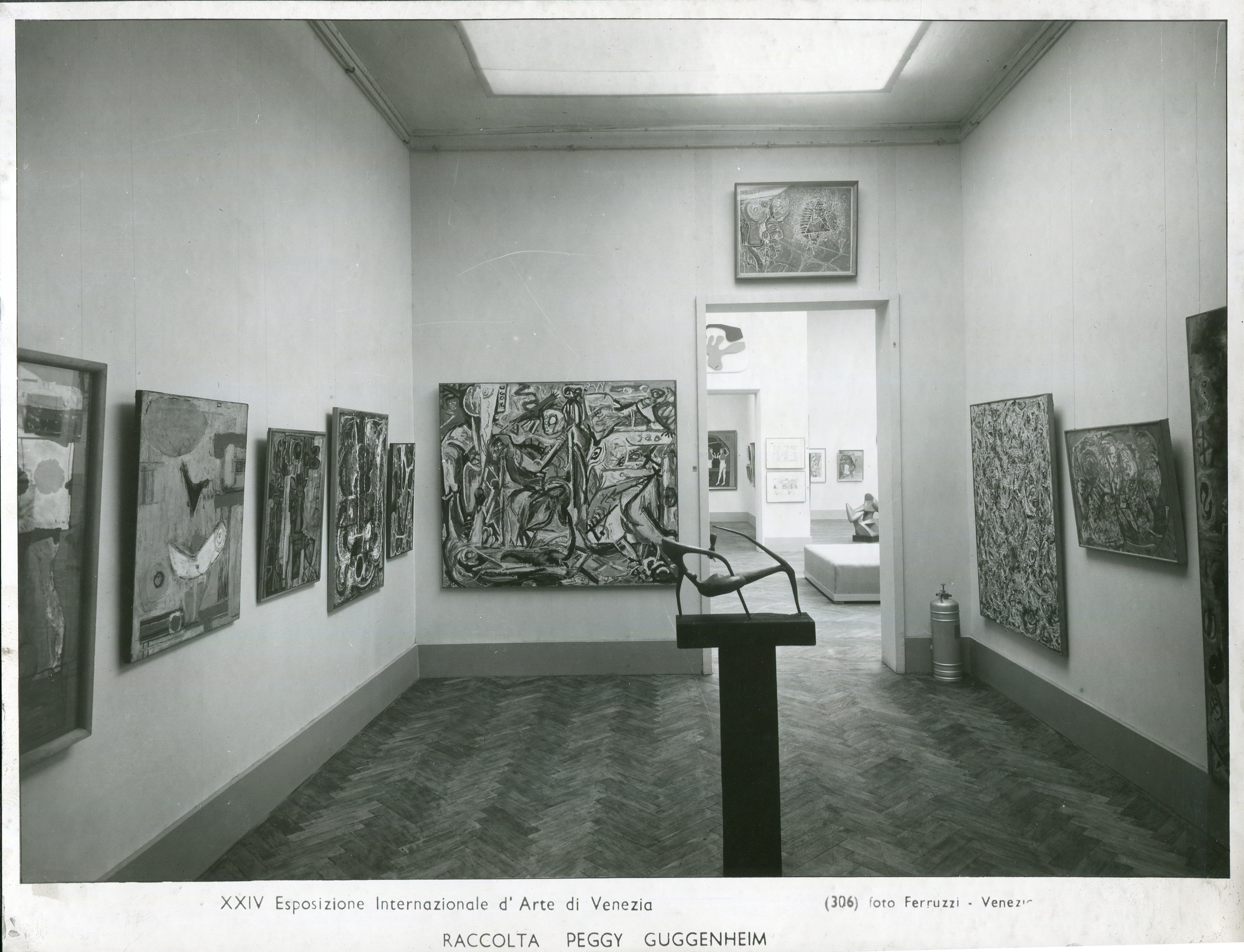
Fig 1.
Venice Biennale Greek Pavilion 1948, showcasing the Peggy Guggenheim Collection.
© Fotografo Ferruzzi, La Biennale di Venezia, ASAC, Fototeca, Attualità e allestimenti, 1948
Through jazz, Davie learnt how to create balance between recognisable structure and spontaneous expression, and by 1948 he was on a mission to achieve this in his painting.

Fig 2.
Bili Davie, Studio with Wood Burner, ink on paper, probably Venice, 1948
© Alan Davie
After the war, Davie spent a year travelling with a well-known band as a Jazz Saxophonist. It was at this time that his sweetheart Bili, his music and his poetry were the main passions in his life. Painting, although a constant activity, had become a contentious struggle for the artist. Through jazz, Davie learnt how to create balance between recognisable structure and spontaneous expression, and by 1948 he was on a mission to achieve this in his painting, striving to paint the way he “had learned to write and to play jazz.”[5] His travel journals from this year together with a collection of works on paper drawn by his wife Bili, illustrate the metamorphosis that Davie undertook, revealing that 1948 was the foundation for his career as an artist.
During his travels, Davie gained what he described as an immense fund of knowledge. This depth of understanding of classical rules from the great Old Masters allowed Davie to improvise and begin to push boundaries in his work whilst maintaining a balance between colour, tone and movement of line, in a similar way that he was able to improvise around a melody with his saxophone. This creative urge was not only expressed in painting and as a jazz saxophonist but also as a piano player, a jewellery maker, an amateur pilot and a poet. He described his work as an organic life force as if he was somehow separate to it and as much in awe of the finished article as the spectator, believing there was "some kind of primal spiritual, almost sexual force"[6] which urged him to create. Davie stated, "when I am working well I work with some sort of unconscious creativity.”[7]
"when I am working well I work with some sort of unconscious creativity.”
His painting can be compared to looking at a still from an old-fashioned film reel, always in flux, as if alive itself, never fully finished. It was common for Davie to paint until a piece appeared complete and then to totally destroy it time and time again. Working on several pieces simultaneously, and often over a number of years, he repeated this process relentlessly before submitting a piece for an exhibition. He saw this as a natural evolutionary process that brought life to his work; “Nature makes all sorts of extraordinary creations, like dinosaurs and then wipes them all out.”[8]
While music was an inspiration behind his work, locations were also pivotal to his personal development as an artist. Venice was the catalyst for this early self-discovery.[9]
The notable shift in Davie's style in the summer of 1948 and the polemic change in method cannot realistically be explained by Davie's European travels and Old Master encounters alone.
Davie’s visit to the first post-war Venice Biennale was arguably a significant influence in the development of his style. The exhibition lasted for five months from May 1st until September 30th. Due to civil war in Greece, the Greek Pavilion was empty and offered to the influential collector and arts patron Peggy Guggenheim, to showcase her collection (Fig 1). On the outbreak of the Second World War, Peggy had begun a cultural crusade to save modernism from Nazi power and she committed to spending her moderate inheritance buying a piece of artwork a day.
The collection included 136 works by 73 artists including Kandinsky, Klee (a favoured artist of Alan Davie), Pollock, Motherwell, Rothko and Man Ray. Davie arrived in Venice on June 21st, apparently unaware that the Biennale was taking place. He then spent five consecutive days at the exhibition (one of a total of seven separate visits). Davie recalled having a "stimulation hangover" and suffering from “mental and visual exertion”[10] and later experienced “a form of fever” where he recalled hallucinating “visions of shape and colour, so varied and mysterious, changing with every recurring spasm.”[11] He later noted making “ thirty small drawings.”[12] and whilst making no specific reference to any particular artists, in his journal he reflected on the powerful experience of the exhibition as a collective whole.
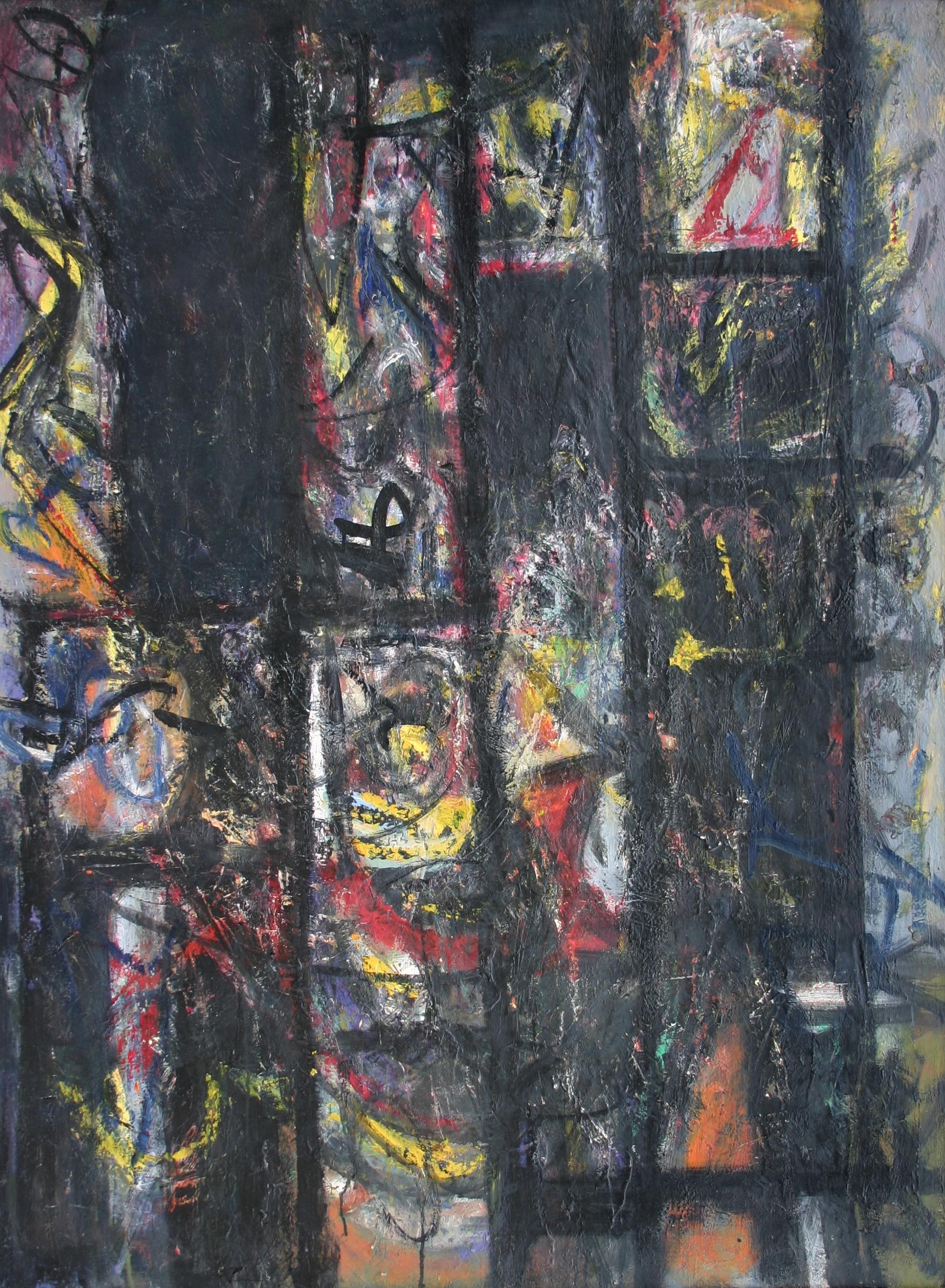
Fig 3.
Pagan Dance, Oil on board (opus 24), 1948, 132 x 99cm.
© 108 Fine Art, Harrogate
“Nature makes all sorts of extraordinary creations, like dinosaurs and then wipes them all out.”
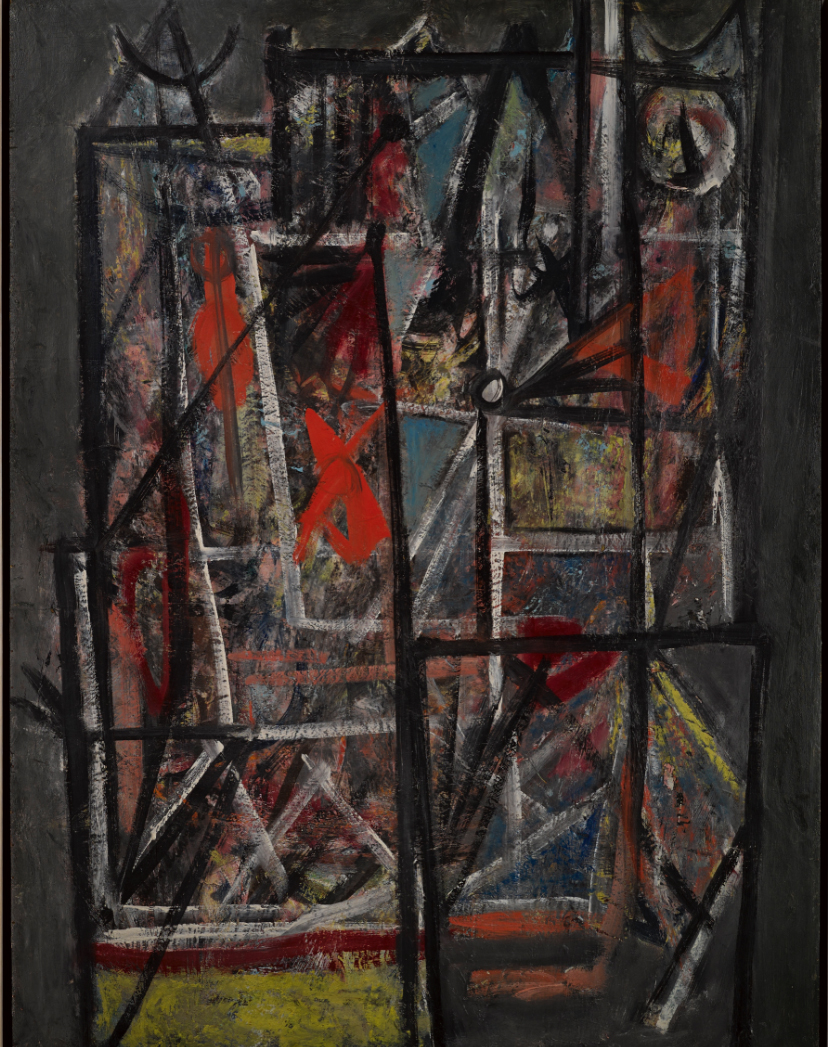
Fig 4.
Alan Davie, Music for an Autumn Landscape (opus 36), 1948, Oil on plywood, 126 x 95 cm
©Tel Aviv Museum of Art. Gift of Peggy Guggenheim, Venice, through American-Israel Cultural Foundation, 1954
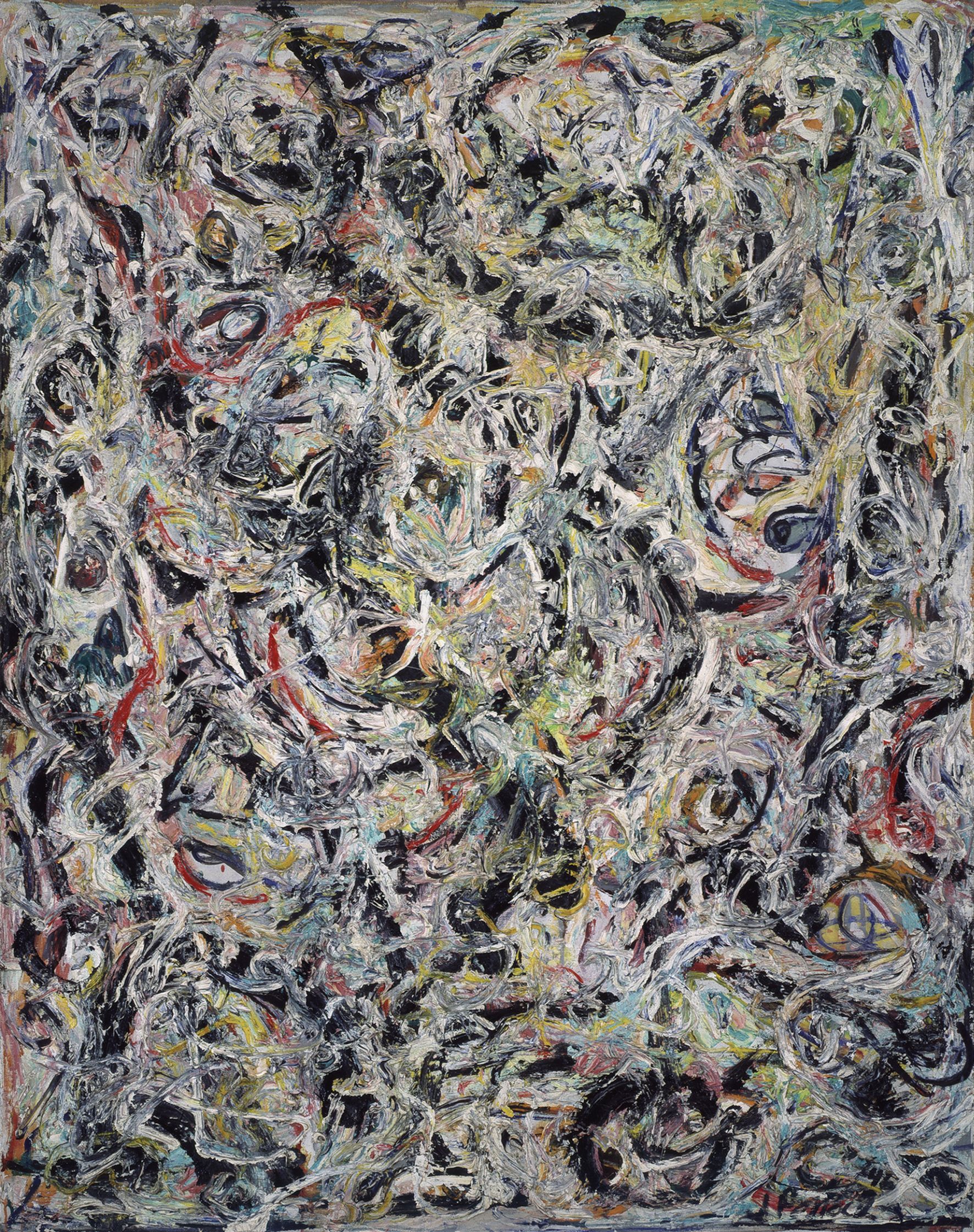
Fig 5.
Jackson Pollock, Eyes in the Heat, 1946, Oil on canvas, 137.2 x 109.2 cm.
©Peggy Guggenheim Collection, Venice 76.2553 PG 149
Another powerful force in his life and career was Davie’s wife, Bili. During their entire life together they only spent two nights apart. As well as cataloguing his work (according to Rene Gimpel the typed opus cataloguing notes were started by Bili in the early 1950's), she made beautiful intimate drawings of the accommodation where they lived and worked in 1948 (Fig 2).
Not only do the drawings reveal the great mess he made when he worked, but also the beginnings of a very kinetic working method. We can see work leant against walls, hung with string, paper taped on the floor, paint being mixed. Palette knives and brushes of various sizes are apparent as are the appearance of many pieces being worked on simultaneously.
A close look at Davie’s work from that year, notably “Pagan Dance” (Fig 3) - the artists second recorded abstract oil on canvas, reveal intense brushstrokes rapidly created with thick impasto applied - either with palette knives, brush or directly from the tube.
Davie was certainly busy painting during the summer of 1948 and we know from Alan's diary that his canvas's and materials were sent to him from home and arrived in Venice during the summer of 1948. So dramatic was his creativity that he produced enough work for two exhibitions, one in Galleria Michaelangelo in Florence, which included 19 paintings according to the archive at Gimpel Fils (Rene Gimpel suggests, according to gallery records, that this exhibition was September; Alan's diary suggests November) and the second exhibition was from 1st - 15th December at Galleria Sandri, Venice, located at the Campo Manin.
As if by the “magic” that Davie so often alluded to, Peggy Guggenheim saw Davie’s exhibition and purchased “Music for an Autumn Landscape” (opus 36), now in the Tel Aviv Art Gallery and for the first time published here (Fig 4). Peggy recalls in her 1960 memoir “Confessions of an Art Addict” strolling through Campo Manin seeing Davie’s work and mistaking it for a Pollock.[13] (*)
On this note it is obviously of great interest to speculate how (or indeed if), his painting style or techniques may have been influenced by works seen at the Biennale of 1948. For example, Pollock’s 1946 work “Eyes in the Heat” (Fig 5) was exhibited and can clearly be seen in the Greek Pavillion (Fig 1) hanging on the right before the doorway. Pollock's 1946 painting "Circumcision" is also visible, central to the room. Davie’s first recorded oil “Opus 23, Vertical Plant Essence” (Fig 6) is, arguably, stylistically close to these works.
Yet, despite seeing a great many Pollock paintings in the Greek pavilion, Davie makes no reference to him in his journal as a direct influence. There has been much debate about the influence of Pollock on Davie; indeed in a letter from the archives of American Art at the Smithsonian Institution, dated January 16th 1949 Peggy Guggenheim writes "In Venice I discovered a young Scottish painter who works like Pollock. It is funny to be influenced by Pollock instead of Picasso. That just shows how time is marching on."[14]
In the 1992 book Alan Davie with essays by Douglas Hall and Michael Tucker there is a general acceptance that Davie reached a similar artistic style to Pollock yet independent of his influence. Davie himself in an interview with British Library Archivist Melanie Roberts in the year 2000 [15] reasserts this. Davie also makes reference in his journals to lively discussions with other travelling artists from varied nationalities about the direction of contemporary painting, revealing a shared ideology. “We were just all saying the same thing, that art is spontaneous, so let’s just let the subconscious flow,” he later observed.
The Ideas of Zen Buddhism, widely discussed at the time resonated with Davie’s desire for spontaneity and freedom in painting. This according to the artist’s own memory led him to mix pigments with household paint for a more fluid painting method, which in turn made working on the floor necessary. “I find I was using that method before I heard of Pollock using it or any of the others… it's not influenced by Pollock it just happens that the qualities arrived at in the process using paint is bound to lead to the same kind of images with paint running.”[16]
After spending five consecutive days at the Biennale (one of a total of seven separate visits), Davie recalls having a "stimulation hangover"
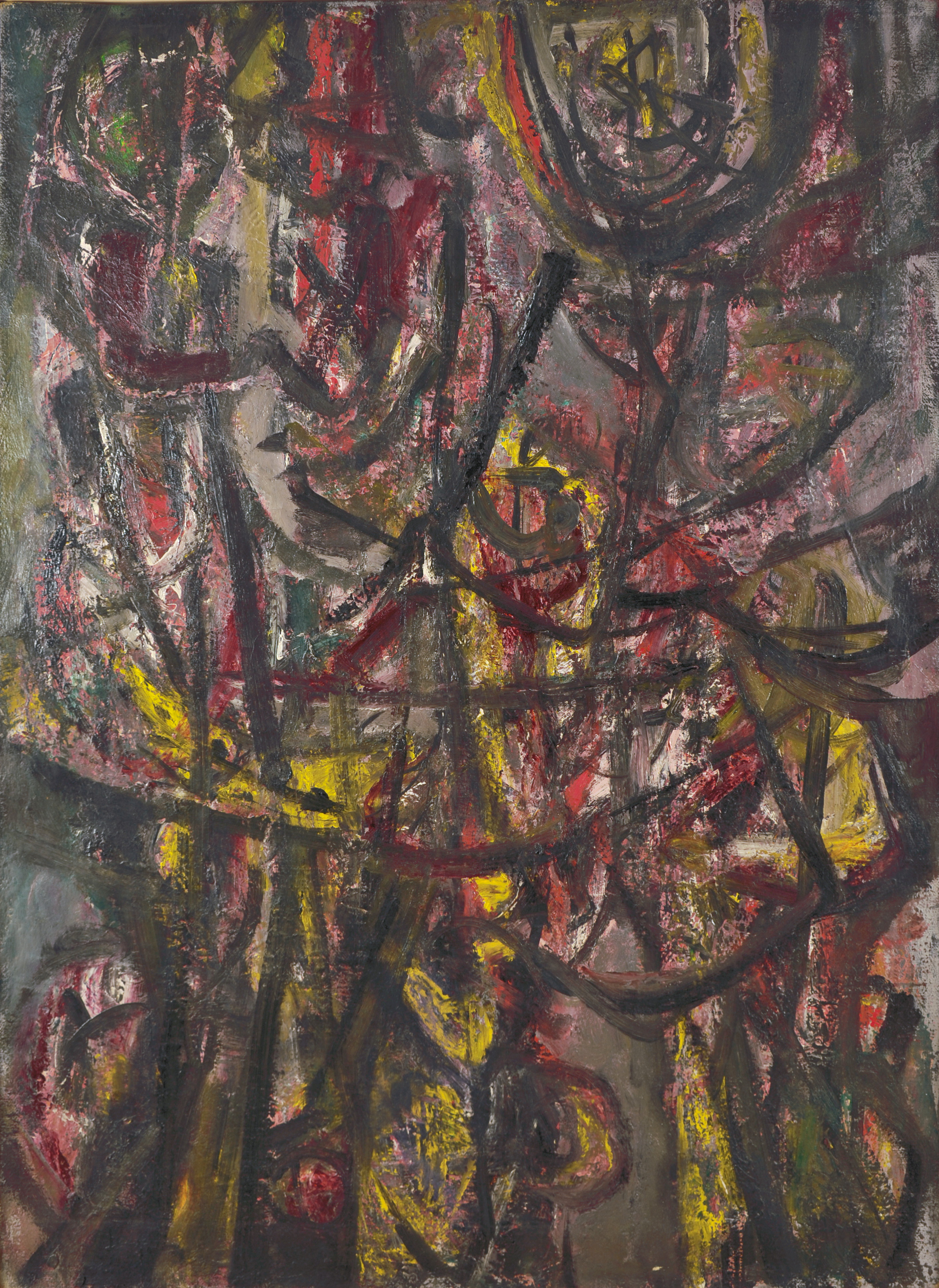
Fig 6.
Vertical Plant Essence 1948, opus 23, Oil on canvas, 122 x 89 cm.
Collection: Gimpel Fils, London. © Gimpel Fils
It's impossible to say whether or not Vertical Plant Essence, Music For an Autumn Landscape or Pagan Dance were painted in this method on the floor. Yet Bili’s drawings do reveal work taped to the floor, which illustrates that Davie was indeed beginning to work in this way during his time in Venice. The similarly between Pollock’s style however and this period of Davie’s work is so striking, and the change in Davie’s work so dramatic, it would seem remiss not to suggest that seeing Pollock wasn’t, at the very least a subconscious influence or an affirmation of ideas conceived already in the artist's mind (see important opus note at end of article). Due to Bili’s dedicated cataloguing of Alan’s work we know “Vertical Plant Essence,” to be his very first abstract oil on canvas and painted in Venice during this period.
Peggy was impressed that a British artist would paint this way. Her memoirs denote surprise at entering the gallery (Galleria Sandri, Venice) and contrary to her expectation, meeting a “tall Scotsman and his equally Scottish looking wife.”[17] It is by the close of 1948 that we can see a further significant change in Davie’s working method; larger paper works with rapid movement. The monoprints in the Tate collection (Fig 7) created November/December 1948, and very reminiscent of Pollock's 1947 'drip' paintings, again appear to show the influence of Pollock on Davie. It is noteworthy however that Philip Rylands, director of the Peggy Guggenheim Collection, has commented that Davie would not have seen Pollock's 1947 (and later) drip paintings at the Biennale.
Davie’s journals in December reveal a satisfaction with his work.
“The last weeks have not been idle. I have produced some hundred monotypes through this wonderful medium. I have discovered so much and so rapidly my work is becoming something very strange… I am beginning to see. Painting shall come with labour and appear one by one…natural things grown upon canvas or board or wood, like multicoloured mossy patches on the forest floor.”[18]
Not only was Peggy able to encourage Davie’s pursuit of self-discovery and method, he was allowed unfettered access to her collection for discussion and inspiration (this, presumably, was in the two month period following Peggy's purchase of Music for an Autumn Landscape and his eventual leaving Venice in February 1949). Latterly, Davie regretted "doing a very naughty thing”[19] after he burned many of his pre-1950 paintings in a huge bonfire. This meant, despite his prolific creativity from 1948, works of this period are comparatively rare and leave few examples from which we can examine his influences during this key period.
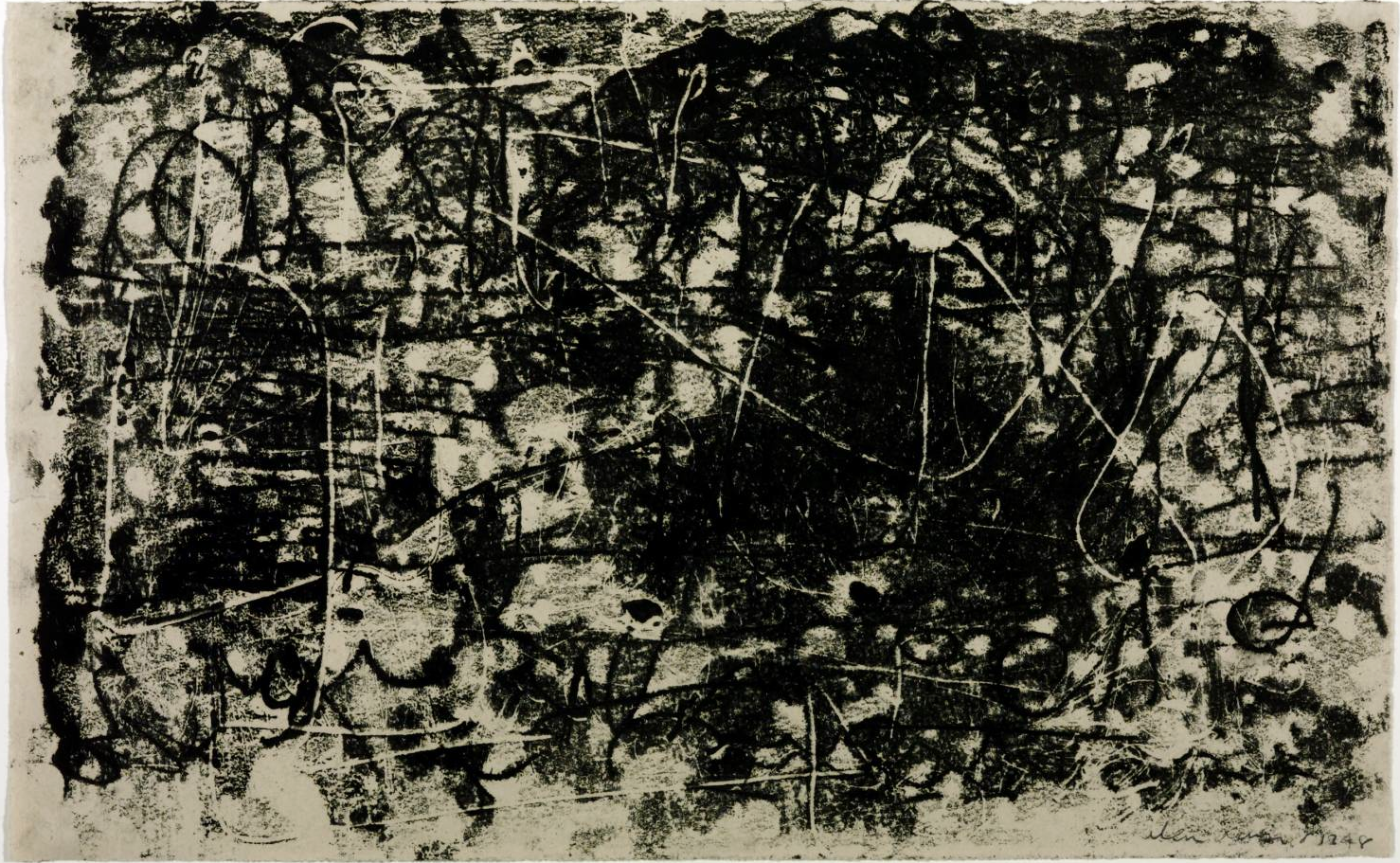
Fig 7. Tate Collection, Alan Davie, Spirit over the landscape, 1948, Monotype on paper, ©Alan Davie
Davie recalled being invited with Bili to dine with Peggy at her favourite restaurant in Venice only to be turned away by the restauranteur, Vittorio Carrain for failing to meet the dress code.
Peggy and Alan were kindred spirits and according to Peggy “became close friends’[20].
Alan recalled being invited with Bili to dine with Peggy at her favourite restaurant in Venice (which, according to Philip Rylands, was probably Ristorante All’Angelo close to St Marks Square) only to be turned away by the restauranteur, Vittorio Carrain (who was to later act as Peggy’s secretary in the early 1950s) for failing to meet the dress code. Despite insisting that their flip-flops would be adequate attire to last out the winter, Peggy immediately bought them shoes so that they could continue with their dinner.
It is possible that this dinner invite came on the same evening that Peggy bought Music for an Autumn Landscape. Alan and Bili had fortuitously called into the gallery and upon meeting Peggy, Alan proceeded to show her a folio of sketches. [21]
This previously unpublished photograph, taken by Charles Gimpel of Gimpel Fils in July 1963, illustrates Peggy in Venice during a moment of quiet contemplation “Peggy opposite the Salute” (Fig 8). The Gimpels regularly visited Peggy so when she wrote to Charles asking him to consider Davie’s work, an enduring friendship was born. Gimpel Fils became Davie’s agents and dealers, so fervent in their belief of his worth, they continued exhibiting his work for seven years before selling a single painting other than those purchased by Peggy. The dedication of Gimpel Fils has continued to this day.
Davie’s creativity was an independent process and separate from the fashionable or popular. He refused to be pigeon-holed or contained by an 'era' or an 'ism'. Davie had a supreme confidence in his role as an artist, and when the Tate held a Davie retrospective he joked that to show all his work he would need more than one exhibition, even in a gallery of that size! This was no exaggeration. Until his final days, Davie was constantly creating; one close friend remembered visiting Davie in the last weeks of his life - even the cards and chocolates that he had been given had been turned into a work of sculpture.[22]
It is to Gimpel Fils we owe our gratitude in preserving one of Britain’s most outstanding painters of the 20th Century. To Peggy for her insight, eye and passionate support and her collection of modern art, to Bili for her love, muse and dedication, to Jazz for inspiring Davie to strive to push boundaries, but ultimately to Alan Davie for his authenticity.
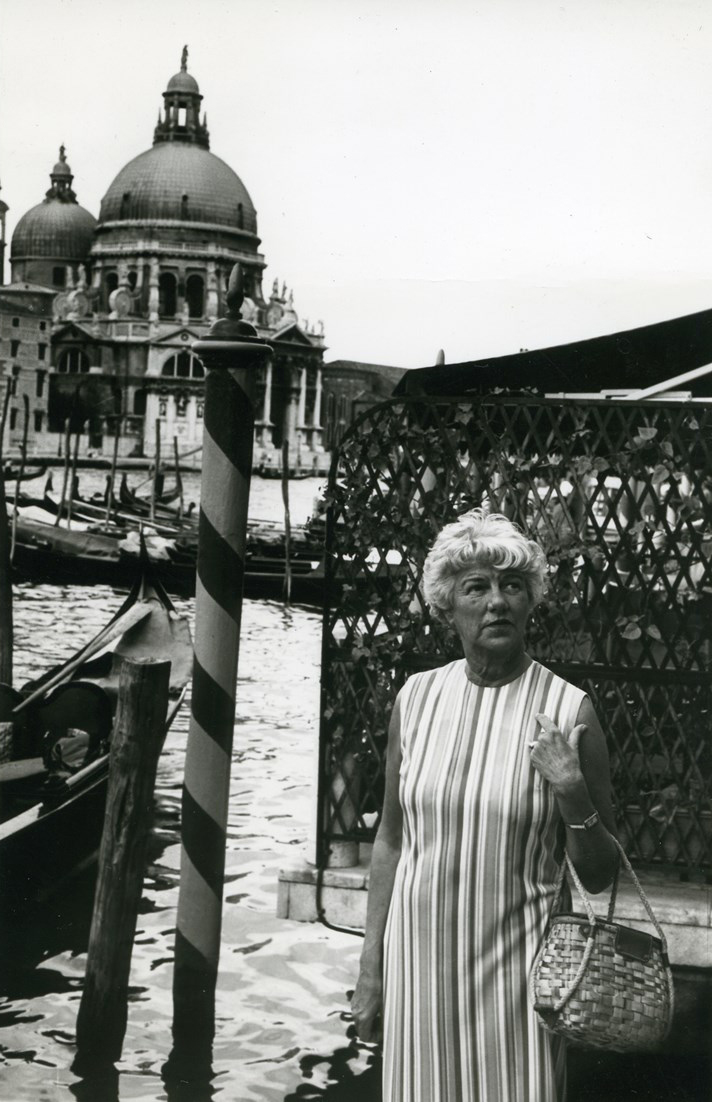
Fig 8.
'Peggy opposite the Salute' taken by Charles Gimpel, July 1963
© E R Gimpel Estate
Important note on opus work cataloguing.
Bili Davie catalogued many of these early works on a typed list which is with Gimpel Fils. The list was created in the early 1950s and references works produced in earlier years. Vertical Plant Essence, opus 23, which the authors here strongly suggest was created between June and September 1948 is not dated in the notes. The next listed work Pagan Dance, opus 24, however is listed as February 1948. It is suggested by the authors that this February date is probably incorrect and that this too was painted slightly later in 1948, during the European tour.
(*) There is a different account than that given by Peggy relating to the first time that Peggy met Alan and Bili. In conversation with Rene Gimpel, Alan Davie recounted that he and Bili called in on Peggy in Venice and took along a portfolio of his work. Peggy showed an immediate interest and it was Peggy who was instrumental in Alan achieving his first Italian exhibitions. A similar account is also relayed by James Coxson who also has recollections of Alan being assisted by Peggy with his second Italian show. Nineteen paintings, six sold, were included in these pre-Gimpel shows. One painting listed as destroyed. If Davie arrived in Venice on June 21st 1948 in the company of fellow artists and with the full knowledge of Peggy Guggenheim's Collection, is it really likely that Davie only met Peggy at the Campo Manin almost six months later?
[1] Alan Davie Obituary, http://www.telegraph.co.uk/news/obituaries/
[2] Travel Journals, Quest for The Miraculous, Michael Tucker
[3] Travel Journals, Quest for The Miraculous, Michael Tucker
[4] I confess by Alan Davie, cited in exhibition catalogue, Visione Colore, Venice, Palazzo Grassi, July-October 1963
[5] I confess by Alan Davie, cited in exhibition catalogue, Visione Colore, Venice, Palazzo Grassi, July-October 1963
[6] Personal account from a close friend of Alan Davie
[7] Talking Pictures episode 14, STV PEOPLE YOUTUBE
[8] Talking Pictures episode 14
[9] EPISODE 9 Rear Window, Rene Gimpel telesur English, YouTube
[10] Travel Journals, Quest for The Miraculous, Michael Tucker
[11] Travel Journals, Quest for The Miraculous, Michael Tucker
[12] Travel Journals, Quest for The Miraculous, Michael Tucker
[13] Confessions of an Art Addict, Peggy Guggenheim
[14] Archives of American Art, Smithsonian Institution, Peggy Guggenheim letter dated January 16th 1949
[15] Davie, Alan (4 of 9). National Life Stories Collection: Artists' Lives.http://sounds.bl.uk/Arts-literature-and-performance
[16] Davie, Alan (4 of 9). National Life Stories Collection: Artists' Lives.http://sounds.bl.uk/Arts-literature-and-performance
[17] Confessions of an Art Addict, Peggy Guggenheim
[18] Travel Journals, Quest for The Miraculous, Michael Tucker
[19] Travel Journals, Quest for The Miraculous, Michael Tucker
[20] Peggy Guggenheim, Confessions of an Art Addict
[21] Personal account from a close friend of Alan Davie
[22] Personal account from a close friend of Alan Davie